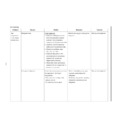LG GR-B-L207EC-ER Service Manual ▷ View online
3-4. Practical Work For Heavy Repair
TROUBLE DIAGNOSIS
- 90 -
Items
Precautions
1. Removal of residual
refrigerant.
1) Remove residual refrigerant more than 5 minutes later after turning off the refrigerator.
( If not, compressor oil may leak inside.)
2) Remove retained refrigerant slowly by cutting first high pressure side (drier part) with a
nipper and then cut low pressure side.
2. Nitrogen blowing
welding.
When replacing a drier:
Weld
a
and
b
parts by blowing nitrogen(0.1~0.2kg/cm
2
) to high pressure side after
assembling a drier.
When replacing a compressor:
Weld
a
and
b
parts by blowing nitrogen to the low pressure side.
Note) For other parts, nitrogen blowing is not necessary because it does not produce oxidized
scales inside pipe because of its short welding time.
3. Replacement of drier.
Inserting a capillary tube
Measure distance with a ruler and put a mark(12
+3/-0
)on the capillary tube. Insert tube to the
mark, and weld it
KEYPOINTING
Observe the sequence for
removal of refrigerant.
(If not, compressor oil may
leak.)
Observe the sequence for
removal of refrigerant.
(If not, compressor oil may
leak.)
KEYPOINTING
Welding without nitrogen
blowing produces oxidized
scales inside a pipe, which
affect on performance and
reliability of a product.
Welding without nitrogen
blowing produces oxidized
scales inside a pipe, which
affect on performance and
reliability of a product.
KEYPOINTING
Be sure to check the
inserted length of capillary
tube when it is inserted. (If
too much inserted, a
capillary tube is clogged by
a filter.)
Be sure to check the
inserted length of capillary
tube when it is inserted. (If
too much inserted, a
capillary tube is clogged by
a filter.)
Compressor
Low pressure side
Condenser
High pressure side
Drier
Evaporator
Release
Refrigent
Intake
Suction
1
2
1
2
Evaporator
Drier
High pressure side
Condenser
Refrigent
Intake
12
+
3
-
0
Filter
* Unit : mm
TROUBLE DIAGNOSIS
- 91 -
Items
Precautions
4.Vacuum degassing.
Pipe Connection
Connect a red hose to the high pressure side and a blue hose to the
low pressure side.
Vacuum Sequence
Open
a
,
b
valves and evacuate for 40 minutes. Close valve
a
.
5.Refrigerant charging.
Charging sequence
1) Check the amount of refrigerant supplied to each model after completing vacuum
degassing.
2) Evacuate bombe with a vacuum pump.
3) Measure the amount of refrigerant charged.
- Measure the weight of an evacuated bombe with an electronic scale.
- Charge refrigerant into a bombe and measure the weight. Calculate the weight of
refrigerant charged into the bombe by subtracting the weight of an evacuated bombe.
KEYPOINTING
- If power is applied
- If power is applied
during vacuum
degassing, vacuum
degassing shall be
more effective.
degassing, vacuum
degassing shall be
more effective.
- Operate compressor
while charging
refrigerant. (It is
easier and more
certain to do like
this.)
refrigerant. (It is
easier and more
certain to do like
this.)
KEYPOINTING
- Be sure to charge
- Be sure to charge
the refrigerant at
around 25
around 25
°
C.
- Be sure to keep -5g
in the winer and
+5g in summer
+5g in summer
the amount of refrigerant charged= a weight after charging -
a weight before charging (a weight of an evacuated cylinder)
a weight before charging (a weight of an evacuated cylinder)
Calculation of amount of refrigerant charged
2
1
3
Compressor
Low
pressure
Condenser
High
pressure
Drier
Evaporator
Red
Yellow
Blue
Vaccum
Pump
Suction pipe
R134a
Indicate the weight of
an evacuated bombe
an evacuated bombe
3-5. Standard Regulations For Heavy Repair
TROUBLE DIAGNOSIS
- 92 -
Items
Precautions
4) Refrigerant Charging
Charge refrigerant while operating a compressor as shown above.
5) Pinch a charging pipe with a pinch-off plier after completion of charging.
6) Braze the end of a pinched charging pipe with copper brazer and take a gas leakage test
on the welded parts.
6. Gas-leakage test
* Take a leakage test on the welded or suspicious area with an electronic leakage tester.
7. Pipe arrangement
Check each pipe is placed in its original
in each cycle
place before closing a cover back-M/C
after completion of work. Particularly
control the size of Joint Drain Pipe
Compressor
Condenser
Drier
Evaporator
Bombe
Rubber
1) Observe the safety precautions for gas handling.
2) Use JIG (or wet towel) in order to prevent electric wires from burning during welding. (In order to prevent insulation
break and accident.)
3) The inner case shall be melted and insulation material (polyurethane) shall be burnt if not cared during welding inner
case parts.
4) The copper pipe shall be oxidized by overheating if not cared during welding.
5) Not allow the aluminum pipes to contact to copper pipes. (In order to prevent corrosion.)
6) Observe that the inserted length of a capillary tube into a drier should be 12 mm.
7) Make sure that the inner diameter should not be distorted while cutting a capillary tube.
8) Be sure that a suction pipe and a filling tube should not be substituted each other during welding. ( High efficiency
pump.)
12 mm
+
3
-
0
Drier
Molecular Pipe
Molecular
Sieves
Sieves
+3
-0
-0
3-6. Brazing Reference Drawings
TROUBLE DIAGNOSIS
- 93 -
PIPE ASSY, JOINT
PIPE ASSY, HOT LINE
(Freezer)
PIPE ASSY, HOT LINE
(Refrigerator)
PIPE ASSY, JOINT
CONDENSER ASSY, WIRE
PIPE ASSY, SUCTION
DRIER ASSY
CAPI - TUBE
Copper Brazer
Copper
Brazer
Brazer
Silver Brazer
Copper
Brazer
Brazer
Copper Brazer
Copper Brazer
Coppper Brazer
Silver Brazer
Copper
Brazer
Brazer
Click on the first or last page to see other GR-B-L207EC-ER service manuals if exist.

